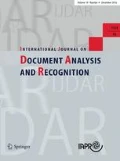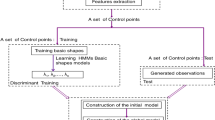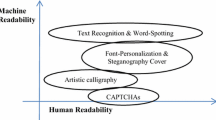Abstract.
This paper proposes a novel learning-based approach to synthesizing cursive handwriting of a user's personal handwriting style by combining shape and physical models. In the training process, some sample paragraphs written by a user are collected and these cursive handwriting samples are segmented into individual characters by using a two-level writer-independent segmentation algorithm. Samples for each letter are then aligned and trained using shape models. In the synthesis process, a delta log-normal model based conditional sampling algorithm is proposed to produce smooth and natural cursive handwriting of the user's style from models.
Similar content being viewed by others
References
Plamondon R, Maarse F (1989) An evaluation of motor models of handwriting. IEEE Trans PAMI 19(5):1060-1072
Singer Y, Tishby N (1993) Dynamical encoding of cursive handwriting. In: Proc. IEEE CVPR
Chen H, Agazzi O, Suen C (1997) Piecewise linear modulation model of handwriting. In: Proc. 4th international conference on document analysis and recognition, Ulm, Germany, pp 363-367
Plamondon R, Alimi A, Yergeau P, Leclerc F (1993) Modeling velocity profiles of rapid movements: a comparative study. Biol Cybern 69:119-128
Li X, Parizeau M, Plamondon R (1998) Segmentation and reconstruction of on-line handwritten scripts. Pattern Recog 31(6):675-684
Beigi H (1996) Pre-processing the dynamics of on-line handwriting data, feature extraction and recognition. In: Proc. 5th international workshop on frontiers of handwriting recognition, Colchester, UK, pp 255-258
Guyon I (1996) Handwriting synthesis from handwritten glyphs. In: Proc. 5th international workshop on frontiers of handwriting recognition, Colchester, UK
Wang J, Wu C, Xu YQ, Shum HY, Ji L (2002) Learning-based cursive handwriting synthesis. In: Proc. 8th international workshop on frontiers of handwriting recognition, Canada
Duta N, Jain AK, Dubuisson-Jolly M-P (2001) Automatic construction of 2D shape models. IEEE Trans PAMI 23(5):433-446
Cootes T, Taylor C (2000) Statistical models of appearance for computer vision. Draft report, Wolfson Image Analysis Unit, University of Manchester, UK
Casey RG, Lecolinet E (1996) A survey of methods and strategies in character segmentation. IEEE Trans PAMI 18(7):690-706
Proctor S, Illingworth J, Mokhtarian F (2000) Cursive handwriting recognition using hidden Markov models and a lexicon-driven level building algorithm. IEE Proc Vis Image Signal Process 147(4):332-339
Munich ME, Perona P (1999) Continuous dynamic time warping for translation-invariant curve alignment with applications to signature verification. In: Proc. IEEE international conference on computer vision, Greece
Miller E, Matsakis N, Viola P (2000) Learning from one example through shared densities on transforms. In: Proc. IEEE CVPR, Hilton Head, SC
Rowley H (1999) Neural network-based face detection. Ph.D Thesis, Sect. 2.3, Carnegie Mellon University, Pittsburgh
Guerfali W, Plamondon P (1995) The delta lognormal theory for the generation and modeling of handwriting recognition. In: Proc. ICDAR, pp 495-498
Plamondon R, Guerfali W (1996) Why handwriting segmentation can be misleading? In: Proc. 13th international conference on pattern recognition, Vienna, Austria, pp 396-400
Press W, Teukolsky S, Vetterling W, Flannery B (1992) Numerical recipes in C, 2nd edn. Cambridge University Press, Cambridge, UK
Srihari S, Cha S, Arora H, Lee S (2002) Individuality of handwriting. J Forensic Sci 47(4):1-6
Author information
Authors and Affiliations
Corresponding author
Additional information
Received: 26 April 2003, Accepted: 27 September 2004, Published online: 29 November 2004
Correspondence to: Jue Wang
Jue Wang and Chenyu Wu completed this work while interns at Microsoft Research Asia.
Rights and permissions
About this article
Cite this article
Wang, J., Wu, C., Xu, YQ. et al. Combining shape and physical modelsfor online cursive handwriting synthesis. IJDAR 7, 219–227 (2005). https://doi.org/10.1007/s10032-004-0131-6
Issue Date:
DOI: https://doi.org/10.1007/s10032-004-0131-6




